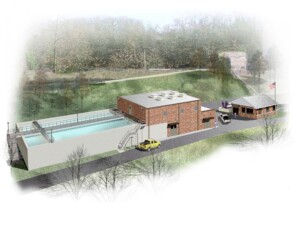A Wastewater Plant Takes Steps to Limit Pollution Into the Chesapeake Bay with Help from Haskell
The Maryland Department of the Environment began working toward a cleaner Chesapeake Bay by breaking ground to construct an upgrade to the Indian Head Wastewater Treatment Plant. They chose Haskell to upgrade and expand their existing .5-mgd sewage treatment plant to reuse quality effluent meeting the requirements of the Chesapeake Bay Restoration Act.
Advanced Technology On A Tight Timeline

The plant design included enhanced nutrient reduction technology that delivered dramatically reduced levels of nitrogen and phosphorus from being discharged into the Chesapeake Bay from that region. Excess nutrients, like nitrogen and phosphorus, degrade water quality, which negatively impact the ecology of the Bay and its tributaries.
A Sustainable Solution to Problematic Nutrient Pollution
The Indian Head Wastewater Treatment Plant upgrade has removed an estimated 22,842 lbs. of nitrogen, annually, that would have been discharged directly from the plant into Mattawomen Creek, the Potomac River and ultimately the Chesapeake Bay. We’re proud to have a part in helping the state preserve the local environment and make Maryland a cleaner, safer place to live.
Green Features
- LEED® Silver Certified – 36 points
- Reduced Nutrient Discharge – Enhanced nutrient reduction technology dramatically reduces the level of nitrogen and phosphorus being discharged into surrounding waters.
- Water Conservation – Low-flow toilets, lavatory faucets and sinks resulted in a 37 percent decrease in the use of potable water.
- Materials – 20 percent of building materials came from recycled sources, and nearly 50 percent were produced regionally. Diverted 85 percent of construction waste from landfills.
Brown and Caldwell-designed Wastewater Treatment Plant Awarded Prestigious LEED® Green Building Certification
The U.S. Navy’s $13.9 million Indian Head Wastewater Treatment Plant Control/Laboratory Building in Indian Head, Md., has been awarded the LEED Silver certification by the U.S. Green Building Council and verified by the Green Building Certification Institute (GBCI). Brown and Caldwell partnered with Haskell to design and construct the upgrades to the 0.5-mgd STP using the design-build delivery method.
LEED is the nation’s preeminent program for the design, construction and operation of high performance green buildings. “LEED certification is good news for the Navy and good news for the Chesapeake Bay Watershed,” said Brown and Caldwell project manager Pete Schuler. “The design features will help the facility operate more sustainably and meet lower nutrient limits.” The facility achieved LEED certification for energy use, lighting, water and material use as well as incorporating a variety of other sustainable strategies. By using less energy and water, LEED certified building saves money for families, businesses and taxpayers; reduces greenhouse gas emissions; and contributes to a healthier environment for residents, workers and the larger community.
“The green building movement offers an unprecedented opportunity to respond to the most important challenges of our time, including global climate change, dependence on non-sustainable and expensive sources of energy and threats to human health,” said Rick Fedrizzi, President, CEO & Founding Chair, U.S. Green Building Council. “The work of innovative building projects such as the Indian Head STP is a fundamental driving force in the green building movement.” LEED certification of the Indian Head plant was based on a number of green design and construction features that positively impact the project itself and the broader community. These features include:
- Energy and water conservation and efficiency: Landscaping was designed so that no irrigation was necessary, used porous pavement, low flow fixtures (faucets, water closets,sinks to decrease use by 37%)
- Use of recovered and recycled materials: 20% of the building materials contained recycled content and 85% of the construction waste was diverted from landfills
- Reduction or elimination of toxic and harmful substances: Project utilized low VOC paints, coatings, adhesives, and sealants. In addition, the project installed UV disinfection to eliminate the need to use chlorine gas and sulfur dioxide gas for chlorination / dechlorination.
- Efficiency in resource and materials utilization: 45% of the total building materials extracted, harvested, recovered or manufactured within 500 miles of the project site.
- Development of healthy, safe and productive work environments: 99% of the regularly occupied spaces have access to views and daylighting.
The improved wastewater treatment plant also includes new headworks (screening and grit removal), influent pump station, continuous inflow SBRs, Blue Water upflow filters, UV disinfection, post aeration tanks, and a new control/laboratory building. In addition, the old aeration basins were converted to new aerobic digesters and most of the old wastewater treatment plant was demolished to avoid increasing the impervious area at the site.


